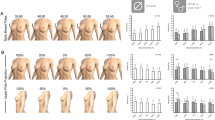Abstract
OBJECTIVE: To identify sociodemographic characteristics, numeracy level, and breast cancer risk factors that are independently associated with the accuracy of lifetime and 5-year breast cancer risk perceptions.
DESIGN: Cross-sectional survey. A probability scale was used to measure lifetime and 5-year risk perceptions. The absolute difference between perceived risk and the Gail model risk of breast cancer was calculated. Linear regression models were built to predict lifetime and 5-year breast cancer risk estimation error.
SETTING: Primary care internal medicine practices (N=2).
PARTICIPANTS: Two hundred fifty-four women 40 to 85 years of age.
RESULTS: The mean lifetime and 5-year calculated breast cancer risk was 8.4% (SD [standard deviation] 6.1) and 1.5% (SD 1.3), respectively. Subjects had a mean estimation error for lifetime and 5-year risk of 29.5% (SD 22.9) and 24.8% (SD 23.9), respectively. In multivariate analyses, lower numeracy scores (0.005), higher number of previous breast biopsies (0.016), and a higher number of first-degree relatives (0.054) were predictive of larger estimation error for lifetime breast cancer risk. White race (0.014), lower educational levels (0.009), higher number of previous breast biopsies (0.008), and higher number of first-degree relatives (0.014) were predictive of larger estimation error for 5-year risk.
CONCLUSION: Among a primary care population, breast cancer risk factors may be more consistently associated with pessimistic perceptions of breast cancer risk than other factors studied during a lifetime and 5-year time span. Primary care physicians should consider counseling patients about individual breast cancer risk factors and risk over time.
Similar content being viewed by others
References
Eiser JR. Communication and interpretation of risk. Br Med Bull. 1998;54:779–90.
Black WC, Nease RF, Tosteson AN. Perceptions of breast cancer risk and screening effectiveness in women younger than 50 years of age. J Natl Cancer Inst. 1995;87:720–30.
Harris RP, Fletcher SW, Gonzalez JJ, et al. Mammography and age: are we targeting the wrong women? A community survey of women and physicians. Cancer. 1991;67:2010–4.
Alexander NE, Ross J, Sumner W, Nease RF, Littenberg B. The effect of an educational intervention on the perceived risk of breast cancer. J Gen Intern Med. 1996;11:92–7.
Schwartz LM, Woloshin S, Black WC, Welch HG. The role of numeracy in understanding the benefit of screening mammography. Ann Intern Med. 1997;127:966–72.
Daly MB, Lerman CL, Ross E, Schwartz MD, Sands CB, Masny A. Gail model breast cancer risk components are poor predictors of risk perception and screening behavior. Breast Can Res Treat. 1996;41:59–70.
Lipkus IM, Samsa G, Rimer BK. General performance on a numeracy scale among highly educated samples. Med Decis Making. 2001;21:37–44.
Gail MH, Brinton LA, Byar DP, et al. Projecting individualized probabilities of developing breast cancer for white females who are being examined annually. J Natl Cancer Inst. 1989;81:1879–86.
Fisher B, Constantino JP, Wickerham DL, et al. Tamoxifen for the prevention of breast cancer: report of the National Surgical Adjuvant Breast and Bowel Project P-1 Study. J Natl Cancer Inst. 1998;90:1371–88.
Costantino JP, Gail MH, Pee D, et al. Validation studies for models projecting the risk of invasive and total breast cancer incidence. J Natl Cancer Inst. 1999;91:1541–8.
Benichou J, Gail MH, Mulvihill JJ. Graphs to estimate an individualized risk of breast cancer. J Clin Oncol. 1996;14:103–10.
Lipkus IM, Kuchibhatla M, McBride CM, et al. Relationships among breast cancer perceived absolute risk, comparative risk, comparative risk, and worries. Cancer Epidemiol Biomarkers Prev. 2000;9:973–5.
Hughes C, Lerman C, Lustbader E. Ethnic differences in risk perception among women at increased risk for breast cancer. Breast Cancer Res Treat. 1996;40:25–35.
Smith BL, Gadd MA, Lawler C, et al. Perception of breast cancer risk among women in breast center and primary care settings: correlations with age and family history of breast cancer. Surgery 1996;120:297–303.
Bowen D, Hickman KM, Powers D. Importance of psychological variables in understanding risk perceptions and breast cancer screening of African American women. Women’s Health. 1997;3:227–42.
Lerman C, Daly M, Sands C, et al. Mammography adherence and psychological distress among women at risk for breast cancer. J Natl Cancer Inst. 1993;85:1074–80.
Kash KM, Holland JC, Osborne MP, Miller DG. Psychological counseling strategies for women at risk of breast cancer. J Natl Cancer Inst Monogr. 1995;17:73–9.
Woloshin S, Schwartz LM, Black WC, Welch HG. Women’s perception of breast cancer risk: how you ask matters. Med Decis Making. 1999;19:221–9.
Woloshin S, Schwartz LM, Byram S, Fischhoff B, Welch HG. A new scale for assessing perceptions of chance. Med Decis Making. 2000;20:298–307.
Diefenbach MA, Weinstein ND, O’Reilly J. Scales for assessing perceptions of health hazard susceptibility. Heath Educ Res. 1993;8:181–92.
Author information
Authors and Affiliations
Corresponding author
Additional information
This work was supported by an American Cancer Society Cancer Control Career Development Award to Dr. Schapira.
Rights and permissions
About this article
Cite this article
Davids, S.L., Schapira, M.M., McAuliffe, T.L. et al. Predictors of pessimistic breast cancer risk perceptions in a primary care population. J GEN INTERN MED 19, 310–315 (2004). https://doi.org/10.1111/j.1525-1497.2004.20801.x
Issue Date:
DOI: https://doi.org/10.1111/j.1525-1497.2004.20801.x




